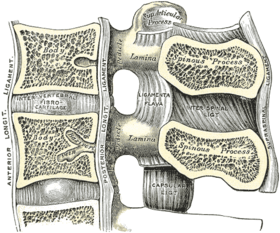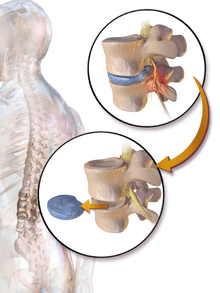Discectomy
A discectomy (also called open discectomy, if done through a 1/2 inch or larger skin opening) is the surgical removal of abnormal disc material that presses on a nerve root or the spinal cord. The procedure involves removing a portion of an intervertebral disc, which causes pain, weakness or numbness by stressing the spinal cord or radiating nerves. The traditional open discectomy, or Love's technique, was published by Ross and Love in 1971. Advances have produced visualization improvements to traditional discectomy procedures (e.g. microdiscectomy, an open discectomy using an external microscope typically done through a 1 inch or larger skin opening), or endoscopic discectomy (the scope passes internally and typically done through a 2 mm skin opening or larger, up to 12 mm). In conjunction with the traditional discectomy or microdiscectomy, a laminotomy is often involved to permit access to the intervertebral disc. Laminotomy means a significant amount of typically normal bone (the lamina) is removed from the vertebra, allowing the surgeon to better see and access the area of disc herniation.
| Discectomy | |
|---|---|
 Median sagittal section of two lumbar vertebrae and their ligaments. ("Intervertebral fibrocartilage", an old name for the intervertebral disc, labeled at center left.) | |
| ICD-9-CM | 80.51 |
| MeSH | D017586 |
| MedlinePlus | 007250 |

Endoscopic discectomy
Small or ultra-small endoscopic discectomy (called Nano Endoscopic Discectomy) does not have internal cutting or bone removal and, due to the small size, is not called "open". These procedures do not cause post-laminectomy syndrome (Failed back syndrome).[1][2]
Microdiscectomy
Microdiscectomy is an open (cutting) spine operation in which a portion of a herniated nucleus pulposus is removed by way of a surgical instrument, while using an external operating microscope for lighting and magnification. These procedures almost always have bone removal, and therefore can cause post-laminectomy syndrome (Failed back syndrome).
In the US
In the U.S., it has been estimated that the Medicare system spends over $300 million annually on lumbar discectomies.[3]
See also
- Back pain
- Anterior cervical discectomy and fusion
- Lumbar disc herniation
- Degenerative disc disease
- Failed back syndrome
- List of surgeries by type
References
- Book Chapter - Decision Making in Spinal Care - Chapter 61; Copyright 2013 by Thieme
- "ISASS17 - Regular Poster Presentation Abstracts - Endoscopic Surgery - 455 - Nano Endoscopic Approach for Central Lumbar Disc Herniations".
- Schoenfeld, A. J.; Weiner, B. K. (2010). "Treatment of lumbar disc herniation: Evidence-based practice". International Journal of General Medicine. 3: 209–214. doi:10.2147/ijgm.s12270. PMC 2915533. PMID 20689695.
- Emmett, J. L.; Love, J. G. (1971). "Vesical dysfunction caused by protruded lumbar disk". The Journal of Urology. 105 (1): 86–91. doi:10.1016/s0022-5347(17)61466-6. PMID 5100876.